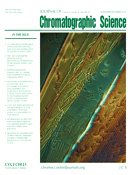
JOURNAL OF CHROMATOGRAPHIC SCIENCE
Scope & Guideline
Catalyzing Discoveries in Chromatographic Techniques
Introduction
Aims and Scopes
- Chromatographic Method Development and Validation:
The journal publishes research on novel and optimized chromatographic methods, including HPLC, GC, and TLC, aimed at enhancing the efficiency, sensitivity, and specificity of analyses. - Application of Chromatography in Pharmacokinetics and Drug Monitoring:
A significant focus is on the application of chromatographic techniques in pharmacokinetic studies and therapeutic drug monitoring, addressing the quantification of drugs and their metabolites in biological matrices. - Environmental and Food Safety Analysis:
Research aimed at the determination of contaminants, pesticides, and residues in food and environmental samples is a core area, highlighting the importance of chromatography in ensuring public health. - Chiral Separations and Enantiomeric Analysis:
The journal frequently features studies on chiral chromatography, focusing on the separation and quantification of enantiomers, which is crucial for pharmaceutical applications. - Green and Sustainable Analytical Chemistry:
A unique contribution of the journal includes the promotion of green chemistry principles in chromatographic methods, emphasizing environmentally friendly practices and reducing chemical waste.
Trending and Emerging
- Integration of Chemometrics with Chromatography:
There is a growing trend in applying chemometric techniques to enhance chromatographic analysis, facilitating better data interpretation and method optimization. - Use of Green Chemistry Principles:
Research focusing on sustainable practices, including the development of eco-friendly solvents and methods, is increasingly prominent, aligning with global efforts towards sustainability in analytical chemistry. - Advanced Chromatographic Techniques:
Emerging methodologies such as ultra-high-performance liquid chromatography (UHPLC) and the use of novel stationary phases are gaining traction, indicating a shift towards more sophisticated analytical capabilities. - Pharmaceutical Applications and Biotechnology:
The journal is seeing an increase in studies related to the analysis of biopharmaceuticals and biologics, reflecting the growing importance of these areas in drug development and quality control. - Multi-Component and Simultaneous Analysis:
There is a notable rise in the publication of studies that focus on the simultaneous analysis of multiple compounds, which is crucial for complex matrices such as biological fluids and environmental samples.
Declining or Waning
- Traditional Chromatographic Techniques:
There is a noticeable decline in the publication of studies solely focused on traditional chromatographic methods without innovative enhancements, as researchers increasingly seek more advanced and efficient techniques. - Non-Analytical Applications of Chromatography:
Research papers that explore non-analytical applications of chromatography, such as basic chemical education or historical perspectives, appear to be waning, as the journal shifts its focus towards practical and impactful applications. - Basic Method Comparisons:
The frequency of papers that primarily compare existing methods without introducing novel insights or improvements has decreased, signaling a trend towards more innovative and application-driven research.
Similar Journals

Separation Science Plus
Unveiling cutting-edge techniques in separation science.Separation Science Plus is an emerging academic journal dedicated to advancing the field of analytical chemistry and separation science. Published by WILEY-VCH Verlag GmbH, this journal provides a platform for researchers to disseminate high-quality studies and reviews that address innovative techniques and breakthroughs in separation methodologies. With its ISSN 2573-1815, the journal has made significant inroads since its inception in 2018, encompassing a convergence period until 2024. Despite currently holding a Q3 ranking in Analytical Chemistry and a Q4 ranking in Filtration and Separation, its dedication to publishing impactful research makes it a vital resource for professionals and students alike. The journal operates under the robust scholarly reputation of WILEY, which is known for its commitment to excellence in scientific communication. Researchers interested in the latest advancements in separation techniques will find Separation Science Plus an essential read, fostering the exchange of knowledge and facilitating greater understanding within this specialized field.
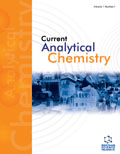
Current Analytical Chemistry
Exploring the forefront of analytical techniques.Current Analytical Chemistry is a pivotal journal in the field of analytical chemistry, published by Bentham Science Publishers Ltd. Established to bridge the gap between fundamental research and practical applications, this journal offers a platform for the dissemination of significant advancements and innovations from the realms of chemical analysis techniques and methodologies. With an impressive scope covering both theoretical and applied analyses, it has successfully secured a Q3 category ranking in the 2023 metrics of Analytical Chemistry, positioned at #75 out of 156 in the Scopus rankings. Researchers, professionals, and students can expect to engage with high-quality content that reflects the latest trends and issues within the discipline. Although it currently does not offer Open Access options, the journal continuously strives to maintain high editorial standards that contribute to its impactful presence in the academic community. The convergence of ideas from 2006 to 2024 promises to uphold its reputation as a reliable source for cutting-edge research in analytical chemistry.
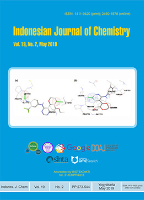
Indonesian Journal of Chemistry
Innovative Insights: Shaping the Future of ChemistryIndonesian Journal of Chemistry (ISSN: 1411-9420), published by Gadjah Mada University, Department of Chemistry, is a premier platform for disseminating innovative research and advancements in the field of chemistry. Established as an Open Access journal since 2001, it promotes wide accessibility to high-quality scholarly articles, fostering collaboration and knowledge-sharing among researchers, professionals, and students in Indonesia and beyond. With an impact factor that places it in Q3 among miscellaneous chemistry journals and a Scopus ranking reflecting its emerging influence (Rank #248/408, 39th Percentile), the journal plays a significant role in enhancing the academic landscape of chemistry. Spanning diverse themes within the discipline, it invites contributions that bridge theoretical and practical aspects, thus contributing to the global conversation on chemical research and innovation. Located in Yogyakarta, Indonesia, the journal reflects a commitment to advancing scientific inquiry while addressing local and global challenges in chemistry.
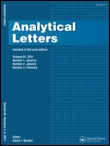
ANALYTICAL LETTERS
Fostering Knowledge in Analytical ResearchANALYTICAL LETTERS is a reputable journal published by Taylor & Francis Inc, focusing on the dynamic fields of analytical chemistry, biochemistry, and clinical biochemistry. With an ISSN of 0003-2719 and an E-ISSN of 1532-236X, the journal has been a platform for scholarly articles since its inception in 1967, and is set to continue its contribution to the scientific community until 2024. Despite its classification in Q3 across various categories as of 2023, including analytical chemistry and spectroscopy, ANALYTICAL LETTERS maintains a significant impact within its field, evidenced by its moderate rankings within Scopus. This journal serves as a vital resource for researchers and professionals seeking to explore recent advancements in analytical methodologies, instrumentation, and applications, facilitating the dissemination of critical insights in laboratory practices. With access primarily through institutional subscriptions, it remains positioned as a crucial tool for those advancing knowledge and innovation in analytical sciences.
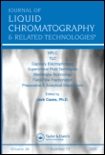
JOURNAL OF LIQUID CHROMATOGRAPHY & RELATED TECHNOLOGIES
Charting New Paths in Liquid Chromatography TechnologiesJOURNAL OF LIQUID CHROMATOGRAPHY & RELATED TECHNOLOGIES, published by Taylor & Francis Inc, is a pivotal platform for disseminating cutting-edge research in the field of liquid chromatography and its applications across various disciplines including analytical chemistry, biochemistry, and pharmaceutical science. With an ISSN of 1082-6076 and an E-ISSN of 1520-572X, this journal serves as an essential resource for researchers, professionals, and students committed to advancing the understanding and development of chromatographic techniques. Despite not being an open access publication, the journal features a robust submission process from 1996 to 2024, ensuring comprehensive coverage of historical and contemporary methodologies. Notably, it has achieved rankings in the Q3 and Q4 quartiles across various categories, reflecting its reputable position in the field. It’s recognized within key databases, with Scopus ranks indicating its influential role in areas such as pharmaceutical science and analytical chemistry. This journal is not only a cornerstone for specialized studies but also fosters interdisciplinary collaborations, making it an invaluable asset for the scientific community.
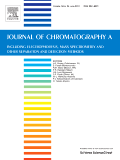
JOURNAL OF CHROMATOGRAPHY A
Connecting Researchers with Cutting-edge DiscoveriesJOURNAL OF CHROMATOGRAPHY A, published by Elsevier, is a leading journal in the disciplines of Analytical Chemistry, Biochemistry, and Organic Chemistry, boasting an impressive 2023 Q2 categorization across multiple fields. With an ISSN of 0021-9673 and an E-ISSN of 1873-3778, this prestigious journal has been at the forefront of chromatography research since its inception in 1958. The journal serves as a vital platform for disseminating high-quality research articles, reviews, and insights into the latest developments in chromatographic techniques and applications, reflecting its standing in the top tier of analytical and organic chemistry literature, evidenced by its impressive Scopus rankings. While it currently operates under a subscription model, the journal continues to make significant contributions to the scientific community by fostering collaboration and innovation in chromatography methodologies. We invite researchers, professionals, and students to engage with the essential findings shared within its pages, which are foundational for advancements in various scientific fields, making it an indispensable resource for enhancing chromatographic knowledge and practice.

CHINESE JOURNAL OF ANALYTICAL CHEMISTRY
Fostering Scientific Inquiry in Analytical ChemistryCHINESE JOURNAL OF ANALYTICAL CHEMISTRY, published by SCIENCE PRESS in China, stands as a prominent platform in the field of analytical chemistry since its inception in 1989. With its ISSN 0253-3820 and E-ISSN 1872-2040, the journal maintains a vital role in disseminating empirical research and innovative methodologies, contributing to the advancement of analytical techniques and their applications. The 2023 Scopus ranking positions the journal in the third quartile (Q3) within its category, reflecting a respectable standing among its peers. Researchers, professionals, and students alike engage with a broad range of topics, from instrumental analysis to environmental monitoring, each aiming to foster further scientific inquiry. Although it does not currently offer Open Access, the journal's rich repository of knowledge continues to be an essential resource for those in the analytical chemistry community, with an enduring commitment to scientific excellence and collaboration.

Analytical Science and Technology
Pioneering research that shapes the landscape of analytical science.Analytical Science and Technology is a prominent journal dedicated to advancing the fields of analytical chemistry and technology, published by the Korean Society for Analytical Science. Based in South Korea, this journal serves as a vital platform for researchers, professionals, and students committed to exploring innovative analytical techniques and methodologies. Although it is classified under Q4 in various subject categories, including Agronomy and Crop Science, Environmental Chemistry, and Pharmacology, the journal aims to provide critical insights and contributions to the scientific community. With ISSN 1225-0163 and E-ISSN 2288-8985, it spans a converged timeline from 2019 to 2024. Despite its current standings in Scopus rankings, the journal is dedicated to improving its visibility and impact through rigorous peer review and high-quality publications, fostering knowledge sharing within its diverse academic fields. Researchers looking for a reliable outlet for their findings are encouraged to consider this journal as it continues to strive for excellence in analytical science.
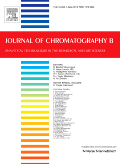
JOURNAL OF CHROMATOGRAPHY B-ANALYTICAL TECHNOLOGIES IN THE BIOMEDICAL AND LIFE SCIENCES
Advancing Analytical Excellence in Biomedical ResearchJOURNAL OF CHROMATOGRAPHY B-ANALYTICAL TECHNOLOGIES IN THE BIOMEDICAL AND LIFE SCIENCES, published by Elsevier, stands as a critical resource in the fields of analytical chemistry, biochemistry, and life sciences. With an impressive convergence of research spanning from 2002 to 2024, this journal delivers high-quality, peer-reviewed articles that advance the methodologies and practices related to chromatographic techniques and their applications in biomedical research. The journal enjoys a reputable standing in the academic community, reflected in its 2023 Scopus rankings—ranked in the 65th and 55th percentiles in Analytical Chemistry and Clinical Biochemistry, respectively. Although it does not offer open access, it provides a vital platform for exchanging innovative ideas and findings, guiding professionals and scholars in addressing the complexities of contemporary biomedical challenges. The journal’s focus on interdisciplinary research positions it as an essential tool for researchers, professionals, and students eager to enhance their knowledge and contribute to advancements in this dynamic field.
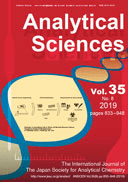
ANALYTICAL SCIENCES
Pioneering Research in Analytical SciencesANALYTICAL SCIENCES, published by SPRINGERNATURE, is a prestigious journal established in 1985 dedicated to advancing the field of analytical chemistry. With an ISSN of 0910-6340 and an E-ISSN of 1348-2246, this journal plays a critical role in disseminating high-quality research and innovative methodologies. Operating from Switzerland, it aims to provide a platform for scholars, researchers, and professionals to explore significant developments and applications in analytical techniques. Although classified in the third quartile (Q3) of analytical chemistry, which places it in a competitive framework (Rank #96/156, 38th Percentile in Scopus), its impact on the discipline is noteworthy. While it is not currently an open-access journal, the resources within are invaluable for those seeking to stay at the forefront of research and practice in analytical sciences, making it an essential read for anyone involved in this dynamic field. The journal continues to converge critical insights from 1985 to 2024, fostering a community dedicated to innovation and excellence in analytical chemistry.